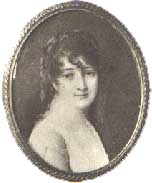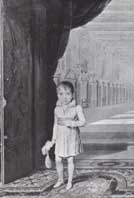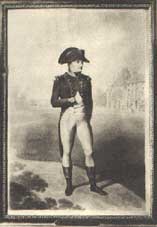After lauding Napoleon to the skies he became the painter of King Louis 18th and of his successors Charles 10th and Louis-Philippe. Exhibiting permanently at the Paris Salon until 1844, Isabey worked under Napoleon 3rd and remained one of the greatest miniature painters of his time.
 His best works were produced during the reign of Napoleon 1st while Foreign minister Talleyrand took him to Vienna to paint the portraits of the envoys who attended the 1814 peace conference. He returned to Paris in 1815 and went to London because the Restoration first treated him with mistrust due to his ties with Napoleon.
His best works were produced during the reign of Napoleon 1st while Foreign minister Talleyrand took him to Vienna to paint the portraits of the envoys who attended the 1814 peace conference. He returned to Paris in 1815 and went to London because the Restoration first treated him with mistrust due to his ties with Napoleon.
On his return in 1820 he was back in favour with King Louis 18th and was in charge of royal festivities. Charles 10th then gave him the title of Royal Draughtsman and painter and appointed him Officer of the Légion d'Honneur in 1825.
In August 1829, after the death of his first wife, Isabey married Mlle Marie-Rose Maistre with whom he had two children.
In 1837 King Louis Philippe appointed him Assistant keeper of the Royal Museums and gave him an apartment in Versailles. He also had the favours of Napoleon 3rd from whom he obtained a pension.
 Isabey influenced many other miniature painters between 1800 and 1840 but after his death there was no one to continue the tradition of small portraits while photography became much popular in the 1850's when people find it more convenient and cheaper to have their portraits produced through that medium.
Isabey influenced many other miniature painters between 1800 and 1840 but after his death there was no one to continue the tradition of small portraits while photography became much popular in the 1850's when people find it more convenient and cheaper to have their portraits produced through that medium.
Still, he was certainly the miniaturist who had the greatest honours and the greatest success during his lifetime. He was an artist with an exceptional skill who knew in addition how to maintain his position under all the regimes.
As a draughtsman he was unrivalled as proved in “La Barque” which represents himself with his first wife and their children (now in the Louvre Museum) as well as the portrait of Vivant Denon.
The miniatures he painted during the 18th century already show in the flesh parts his technique of “pointillist” which consists of crossed brush strokes rather well spaced and mainly directed from top to bottom. He always used for the miniatures of his first period a background of dark brown gouache or occasionally landscape backgrounds also rendered in dark shades so as to make the powdered hair of his sitter to stand out.
About 1800 he broke with this custom and started to use backgrounds of light skies. From the Empire period most of his miniatures were of large sizes and usually painted on vellum stretched on a plaque of enamelled metal on the front to prevent rusting. It was from this period that he produced his aerial portraits by draping gauze veils around the faces of the ladies portrayed. This process enabled him to give a flattering surround and to hide imperfections whilst faithfully reproducing the persons represented. Such invention increased still more his prestige with his female clients while Isabey kept producing high quality miniatures until after he reached the age of 70.
 The number of works he left are enormous as he worked quickly with stunning assurance. The fact that he used vellum for many miniatures probably allowed him to work quicker than on ivory. He also painted numerous portraits in watercolour on card where only the faces and the hair were executed completely and produced some enamel miniatures at the beginning of his career as well as large oil paintings.
The number of works he left are enormous as he worked quickly with stunning assurance. The fact that he used vellum for many miniatures probably allowed him to work quicker than on ivory. He also painted numerous portraits in watercolour on card where only the faces and the hair were executed completely and produced some enamel miniatures at the beginning of his career as well as large oil paintings.
His miniatures were usually signed “Isabey” or “I. Isabey” often followed by the date. His works are almost in all the museums and most of the important private collections. The Isabey room at the Louvre contains 59 miniatures or drawings from his studio which were bequeathed to the museum in 1910. The same museum owns a number of works from the Doistau, Lenoir and David-Weill collections.
The Wallace Collection in London has a large number of miniatures by Isabey, some of which are really beautiful. Other remarkable works by the artist are in the Edward B. Greene collection now in the Museum of Cleveland, Ohio.
Adrian Darmon